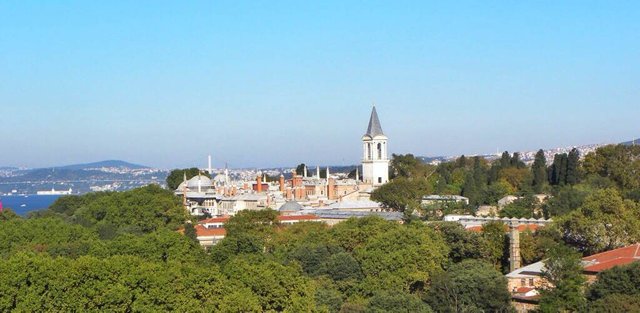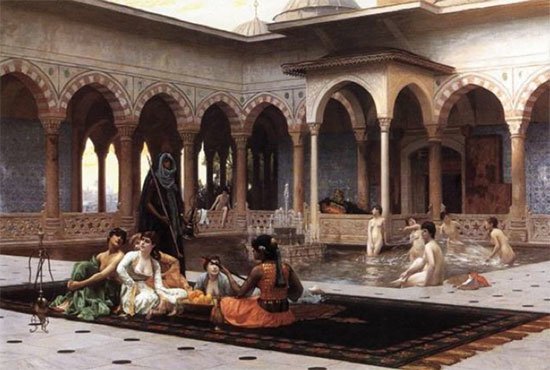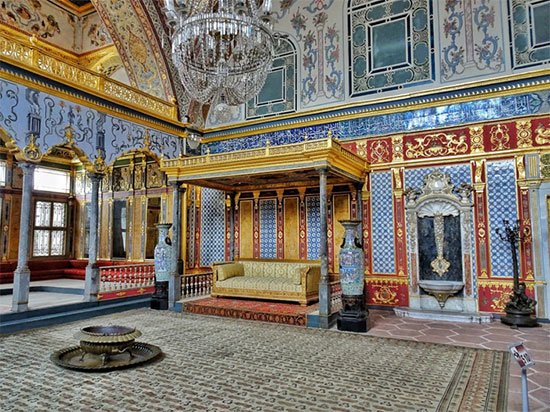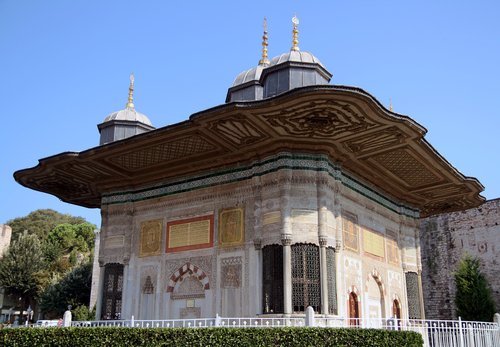The Topkapi Palace (Topkapı Sarayı in Turkish, literally the 'Palace of the Gate of the Cannons' - for being located near a door of that name).
From this palace the sultans ruled their empire until the mid-nineteenth century.

https://www.estambul.net/sitios-de-interes/palacio-topkapi/
The construction of Topkapi Palace began shortly after Mehmed II took Constantinople. The initial palace was inaugurated in 1465. During the following decades the palace was enlarged by the different rulers.
In 1856, Sultan Abdulmecid decided to move his residence to the Dolmabahçe Palace, a western-style palace.
The present city of Istanbul in the past was known as Byzantium or Constantinople, and from all those historical moments there are monumental testimonies in the Turkish capital. However, the Topkapi Palace can be considered as one of the great jewels of ancient Constantinople, when from here the vast Ottoman Empire was ruled, which extended over much of the Mediterranean and distant lands to Turkey.
http://doshaciendofotos.blogspot.com/2014/12/palacio-topkapi-estambul-turquia.html
Like the vast majority of historical monuments in Istanbul, the Topkapi Palace is also located on the European side of the city. In the same place where you can find the big mosques, the Hagia Sophia basilica or the impressive Grand Bazaar.
In its more than 700,000 square meters, the Topkapi Palace has four patios and multiple buildings inside: weapons room, kitchen, royal stables, treasure and many more.
In the same enclosure (inside its walls) is the Archaeological Museum and other buildings of interest.

https://www.nuevatribuna.es/articulo/historia/haren-palacio-topkapi/20170326165217138066.html
The Harem was the place where the Sultan lived, his family and a group of between 500 and 800 women of high cultural level trained in certain skills. The Queen Mother was the head of the Harem.
This harem had three perfectly different parts: that of the black eunuchs, the women's room and the sultan's apartments.
Of the rooms of the Sultan we must emphasize the Imperial Chamber, the hall of the chimneys and the hall of Murat III that continues conserving the original decoration of the XVIth century.
The area of the black eunuchs was covered with spectacular blue tiles.
The second part, the women's area. About three hundred rooms were built, grouped around three courtyards: the one of the Sultana Madre, the one of the favorites and the concubines, that would have given some son to the Sultan and the third patio that of the servants. All these rooms were covered with beautiful tiles with ceilings and domes decorated with frescoes, floral drawings and landscapes.

https://www.nuevatribuna.es/articulo/historia/haren-palacio-topkapi/20170326165217138066.html
The Treasure of Topkapi.
The treasure is one of the most spectacular in the world. The pieces come from different roads, as gifts by foreign agents, jewels of the different sultans, booties of war or inheritance. The treasure is exposed throughout four rooms:
The room of pearls: In this room are the figure of the black slave and that of the sheik sitting on his throne.
Second room: The throne of Ahmed I and the jade nave stand out in this room. In this room is the famous Topkapi dagger. It is the most expensive dagger in the world and is made with gold, diamonds, emeralds and precious stones.
Third room: In this room is the diamond of the spoon, the third largest diamond in the world.
Fourth room: In this room the most important is the Indian-Turkish throne of the eighteenth century.
Each room of Topkapi Palace can be considered a real gem, however when it comes to the so-called Treasure then it becomes much more palpable.

Here some of the most valuable objects in the world are kept. For example, the 88-carat Cucharero diamond is exposed. It also exposes the most expensive weapon in the world, it is the Imperial Dagger, adorned with gold and emeralds.
Well, the treasure that is held here, only shows 10% in the different showcases of the three exhibition rooms. So you have to get an idea of the richness of the place.
The Topkapi Museum.
Actually, the entire Topkapi Palace is a gigantic museum of art and history. But also, inside the walled enclosure that protects it there is a space that is called precisely Archaeological Museum.
In its rooms you can make a review of the entire history of Turkish art, from antiquity to almost today, since there are preserved classic statues, carved sarcophagi, Ottoman ceramics and many elements of the Muslim religion.
Pavilion of the Holy Mantle and the Sacred Relics.

In those that were the private apartments of Sultan Mehmed II, religious objects were shown to the public since 1962 while a magnet reads verses from the Koran, which has been done continuously for more than 500 years.3 4 5 6
Among the most important objects (sent to the Ottoman sultans between the sixteenth century and the late nineteenth century) are the Holy Mantle of the founder of Islam, the Prophet Muhammad, as well as a hair of his beard, the reliquary where one of his teeth, and the bow and sword of the prophet. There is also land from the tomb of Muhammad, a footprint framed in bronze, 139 copies of the Koran of great historical importance for Islam, keys to the Kaaba of the holy mosque in Mecca and personal elements of the prophet's companions as swords, a tray of Abraham, a staff of Moses, the sword of David and the tunic of Joseph.
http://www.bloganavazquez.com/2010/03/27/tesoro-imperial-de-topkapi/
Model of the Topkapı Palace around the 17th-18th centuries that is exhibited in the same palace. Scale model of the Seraglio with the Topkapı Palace Complex
In 1853, Sultan Abdulmecid decided to move his residence to the newly constructed and modern Dolmabahçe Palace. At present, the Topkapı is a museum of the imperial era, being one of the biggest tourist attractions of Istanbul.
Parts of the Palace.
Entry:
Imperial Gate (Bab-Ι Hümayun)
The first patio:
Door of the Host (Bab-üs-Selâm)
The second patio:
Courtyard of ceremonies
Royal Stables (Has Ahirlar)
Private Council (Kubbealti)
Collection of weapons
Mosque of kitchen staff
Patio of the kitchens
Real kitchens
European porcelain and silverware collection in silver
Door of the white eunuchs (Bab-üs-Saadet)
Rooms of the white eunuchs
The third patio:
Hall of the audience (Arz Odasi)
Library of Ahmed III
Mosque of the White Aghas
College of the scout pages
treasure
Residence director museum
Calligraphy, miniatures and portraits collection
Watches collection
Pavilion of the Holy Mantle and the Sacred Relics
The fourth patio:
Mosque «Sofa»
Ornate Pavilion (Mecidiye Köşkü)
Residence of the doctor (Hekimbaşi Odasi)
Pavilion of the hall (Sofa Köşkü)
Revan's Pavilion (Revan Köşkü)
Baghdad Pavilion (Bagdad Köşkü)
Circumcision pavilion
The portico of Iftar
The harem
Buildings located in the palace wall:
River bank pavilion (Yali Köşkü)
Wicker pavilion (Sepetçiler Köşkü)
Maritime Palace of Topkapı (Topkapı Sahil Sarayı)
Pearl Pavilion (Incili Köşk)
Tokapi Gate
Balikhane door.
https://es.wikipedia.org/wiki/Palacio_de_Topkapi